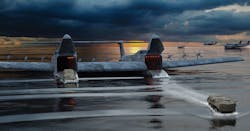Aurora and General Atomics move forward on project to design heavy-lift seaplane to operate in high waves
ARLINGTON, Va. – U.S. military researchers are moving forward with two industry partners on a project to design a futuristic seaplane able to operate in rough seas for weeks at a time, and carry payloads as heavy as 45 tons for distances between 4,000 and 6,500 miles.
Officials of the U.S. Defense Advanced Research Projects Agency (DARPA) in Arlington, Va., have announced two orders collective worth $41.1 million to Aurora Flight Sciences Corp. in Manassas, Va., and to General Atomics Aeronautical Systems Inc. in Poway, Calif., to continue modeling and design of the future Liberty Lifter heavy-lift, long-range seaplane to operate efficiently at very low altitudes in ground effect.
The Liberty Lifter program aims to demonstrate a leap-ahead in operational capability by designing, building, floating, and flying a long-range, low-cost X-Plane capable of seaborne strategic and tactical heavy-lift.
Aurora Flight Sciences working with Gibbs & Cox, a Leidos company in Arlington, Va., and ReconCraft in Clackamas, Ore., while General Atomics is working with Maritime Applied Physics Corp. (MAPC) in Baltimore on the Liberty Lifter project.
The Aurora Flight Sciences and General Atomics teams will use supercomputers for extensive modeling and simulation to design the Liberty Lifter technology demonstration aircraft. Aurora won a $19.5 million order and General Atomics won a $21.5 million order to continue with Liberty Lifter development. The orders were announced on 27 July. The companies won their original Liberty Lifter contracts in November 2022 and April 2023.
The General Atomics team is designing a twin-hull mid-wing design to optimize on-water stability and seakeeping using distributed propulsion with 12 turboshaft engines. Aurora Flight Sciences, meanwhile, is working on a design that more closely resembles a traditional flying boat, with a single hull, high wing, and eight turboprop engines.
The Liberty Lifter long-range seaplane will provide smooth operations in ground effect and in high waves that of four to eight feet. Ground effect describes the added aerodynamic buoyancy produced by a cushion of air below an aircraft moving closely to the ground or surface of the water.
The Aurora Flight Sciences and General Atomics teams are attempting to achieve smooth flight while flying over waves as high as eight to 13 feet, with high lift at low speeds to reduce wave impact loads during takeoff and landing in waves from 4 to 8 feet high. The seaplane is expected to accommodate wave impact loads and be able to operate in high-traffic areas, and operate at sea for weeks at a time with long periods between land-based maintenance.
DARPA researchers are emphasizing low cost, easy-to-fabricate designs, with Liberty Ship-style manufacturing. The seaplane also should have complex aero and hydrodynamic interactions during takeoff and landing, with advanced sensors and controls to avoid rogue wave impacts.
The Liberty Lifter seaplane should be able to take off and land in waves from four to eight feet high; fly in ground effect above waves from 8 to 13 feet high; fly at altitudes from ground effect to 10,000 feet, and operate for four to six weeks at a time carrying payloads of at least 90 tons.
On-water amphibious payload deployment and retrieval should be via nose and tail ramps; the seaplane should be able to carry at least two U.S. Marine Corps Amphibious Combat Vehicles, and cargo in 20-foot container units.
The Aurora Flight Sciences and General Atomics team will use high-performance computing and multi-disciplinary analysis and optimization tools to model and analyze complex aerodynamic and hydrodynamic interactions; focus on affordable design and manufacturing approaches; use novel manufacturing approaches; and use industry best practices from commercial high-speed vessels.
The program consists of a three-phase developmental cycle with each phase building on the previous phase. For more information contact Aurora Flight Sciences online at www.aurora.aero, General Atomics Aeronautical Systems at www.ga-asi.com, or DARPA at www.darpa.mil/program/liberty-lifter.
About the Author
John Keller
Editor-in-Chief
John Keller is the Editor-in-Chief, Military & Aerospace Electronics Magazine--provides extensive coverage and analysis of enabling electronics and optoelectronic technologies in military, space and commercial aviation applications. John has been a member of the Military & Aerospace Electronics staff since 1989 and chief editor since 1995.
